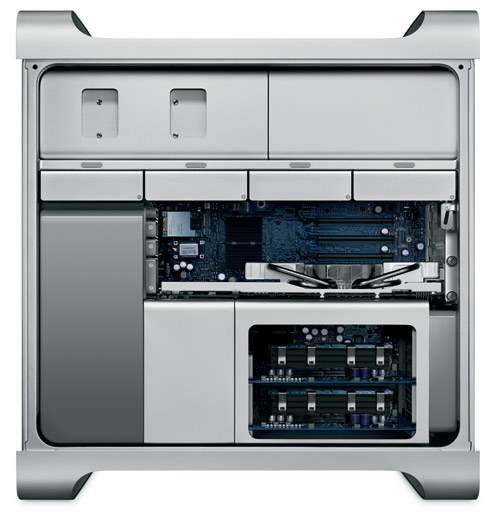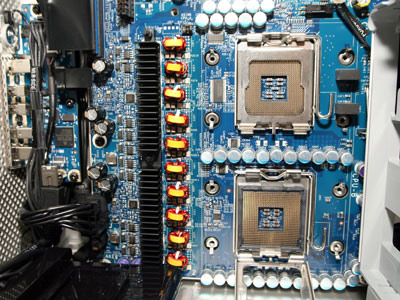Hosted by site sponsor WebMate.
Silver Tower Mac Pro (Dual Optical) Q&A - Updated May 23, 2013
All Mac Q&As >> Silver Tower Mac Pro Dual Optical Q&A (Home)
To be notified of new Q&As, sign up for EveryMac.com's bimonthly email list.
How do you upgrade the processors in the "Original/Early 2008" Mac Pro models? How are the processors mounted?
Please note that this Q&A explains how to upgrade the processors in the original and "Early 2008" Mac Pro models (model identifiers MacPro1,1, MacPro2,1, and MacPro3,1).
EveryMac.com also provides processor upgrade instructions for subsequent Mac Pro models -- the "Early 2009" (MacPro4,1) and "Mid-2010" and "Mid-2012" (MacPro5,1) systems.
Officially, Apple provides no public information regarding whether or not it is possible to upgrade or replace the processors in any Mac Pro models.
As Apple only considers the memory and hard drives to be user upgradable in these systems, EveryMac.com cannot recommend that one upgrade the processor themselves, as doing so is relatively challenging and voids the warranty (should a system of this vintage still be under warranty).
However, for the technically inclined, upgrading the processors in the original and "Early 2008" Mac Pro models is quite possible as the processors are socketed and Apple did not impose any firmware restrictions, either.

Photo Credit: Apple, Inc. (Mac Pro)
Identification Help
If you're not sure which Mac Pro you have, the A1186 Model Number is sufficient to collectively identify the original and "Early 2008" Mac Pro models, all of which use the same type of processor sockets. The model number, as well as the EMC Number, is located on the back of the system in small type.
In software, these models also can be identified by the Model Identifier. To locate the model identifier, select "About This Mac" under the Apple Menu on your computer and click the "More Info..." button. If the Mac Pro is running OS X "Lion" (10.7) or later, click the "System Report" button after clicking "More Info..." as well. Specifically, the original Quad Core Mac Pro models are model identifier MacPro1,1, the Mac Pro "Eight Core" 3.0 (2,1) is model identifier MacPro2,1, and the "Early 2008" Mac Pro models are MacPro3,1.
Specifically, the original and "Early 2008" Mac Pro models include these systems:
Mac Pro |
Model No |
Model ID |
EMC No |
EveryMac.com's Ultimate Mac Lookup feature also can identify these models by their Serial Numbers.
More details about specific identifiers are provided in EveryMac.com's extensive Mac Identification section.
Processor Upgrade Instructions
The processors in the original and "Early 2008" Mac Pro models are mounted on 771-pin LGA Sockets and the internal Apple Service Manual confirms that the processors can be replaced.
Apple roughly provides the following instructions intended for authorized service personnel to replace the processors:
1. Backup all data on the Mac Pro and verify that the backup is successful.
2. Shut down the Mac Pro, unplug it, and disconnect any cords or cables.
3. Prior to opening the case and laying it on its side with the access side facing up, Apple mentions that service personnel may find a "flat-blade screwdriver helpful in releasing the processor holder latch" and notes that:
Every time you remove a processor, you must replace the thermal grease on the processor heatsink. New grease and alcohol wipes for removing the previous grease are included with replacement processors. Instructions for applying the grease are included with the processor heatsinks procedure.
4. Before one can even access the processors, the following components have to be removed:
- Hard drives in drive bays 1 and 2
- Any 12-inch PCI Express cards
- PCI Express card installed in slot 1
- Top and bottom memory cards
- Processor heatsink cover
- Front fan assembly
- Processor heatsinks
- Memory cage
5. Release the processor holder latch on each processor to be replaced (see below). This is where the flat-blade screwdriver may come in handy.

Photo Credit: PowerMax (No Longer Online). In this photo, the processor holder door for CPU A is closed (top) and CPU B is open (bottom). The processors have been removed.
6. Service personnel are then instructed to "rotate the top of the holder to the open position" and "lift the processor out of the holder".
7. When installing the new processor, Apple warns:
When removing or installing a processor, always hold the processor by the edges. Be extremely careful not to touch the gold pins on the bottom of the processor, as this type of connector is very sensitive to contamination. Also be careful not to touch the gold pins in the processor socket on the logic board.
8. Remove the protective cap covering the replacement processor's pins, align the processor "notch" with the "tab on the processor holder", place the processor in the socket, close the "door", and close the processor holder latch as well.
9. Before reinstalling the heatsinks, Apple reminds service personnel to "make sure the two logic board bumpers by the upper processor are in place."
These semi-official instructions assume that one will be replacing the processors and heatsinks together. If you are upgrading the processors alone, readers also have advised to purchase a long T15 Torx wrench to make it easiest to remove the heatsinks from the processors.
Third-Party Processor Upgrade Confirmation & Tutorials
A few months after the introduction of the original Mac Pro -- but prior to the April 4, 2007 release of the Mac Pro "Eight Core" 3.0 (2,1) which has two 3.0 GHz "Quad Core" Xeon X5365 (Clovertown) processors -- AnandTech got their hands on engineering samples of pre-release Intel "Clovertown" processors, and the author reported that:
We grabbed a pair of 2.4 GHz Clovertown samples and tossed them in the system, and to our pleasure, they worked just fine. Our samples used a 1066 MHz FSB, although we're expecting the final chip to use a 1333 MHz FSB, but the most important part of the test is that all 8 cores were detected and functional.
As time has gone on, EveryMac.com readers have e-mailed to confirm that they also have been successful upgrading the processor in the original Mac Pro models. Swapping out the default two dual core processors on "Quad Core" models with two quad core processors (to make it an "Eight Core" system) has been rather popular.
Specifically, many have reported successfully replacing the Dual Core Xeon 5130, 5150, or 5160 processors with 2.66 GHz Quad Core Xeon 5355 processors or 3 GHz Quad Core Xeon 5365 processors. AnandTech has a brief teardown that may be useful to you and XLR8YourMac has a number of reader reports that also may be worthwhile. However, perhaps the best step-by-step guide is from a helpful Italian Mac user who swapped out the default processors with a pair of 1.86 GHz Quad Core Xeon E5320 processors.
Processor Upgrade Video Tutorial
Although this two part video tutorial from talented musician Kays Alatrakchi (midphase) could have benefited from prepared copy and a tighter edit, it also can be quite useful for anyone upgrading the processor in the original or "Early 2008" Mac Pro:
Processor Upgrade Summary
Ultimately, it is quite possible to upgrade the standard processors in the original or "Early 2008" Mac Pro models with faster ones available at the time the system was new or even more recent processors. However, it is not the easiest upgrade to perform and only should be attempted by one who has experience upgrading the processor in other systems.
By reading the semi-official instructions and unofficial tutorials as well as watching the videos above, it is hoped that you will be able to decide whether or not upgrading the processors in your original or "Early 2008" Mac Pro is a challenge you would like to tackle. Best of luck!
Successfully upgraded the processor in any Mac Pro model? Please share the results of your efforts. Thank you.
Also see:
- How do you upgrade the processors in the "Early 2009" Mac Pro models? How are the processors mounted?
- How do you upgrade the processors in the "Mid-2010" and "Mid-2012" Mac Pro models? How are the processors mounted?
Permalink | Report an Error/Typo | Sign Up for Site Update Notices
<< Mac Pro Dual Optical Drives Q&A (Main) | All Mac Q&As
Established in 1996, EveryMac.com has been created by experts with decades of experience with Apple hardware. EveryMac.com includes, and always has included, original research incorporating detailed, hands-on inspection of packaging, computers, and devices as well as extensive real-world use. All information is provided in good faith, but no website or person is perfect. Accordingly, EveryMac.com is provided "as is" without warranty of any kind whatsoever. EveryMac.com, and the authors thereof, shall not be held responsible or liable, under any circumstances, for any damages resulting from the use or inability to use the information within. For complete disclaimer and copyright information please read and understand the Terms of Use and the Privacy Policy before using EveryMac.com. Copying, scraping, or use of any content without expressed permission is not allowed, although links to any page are welcomed and appreciated.
